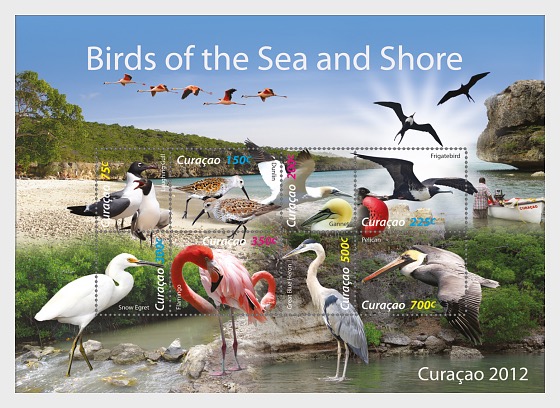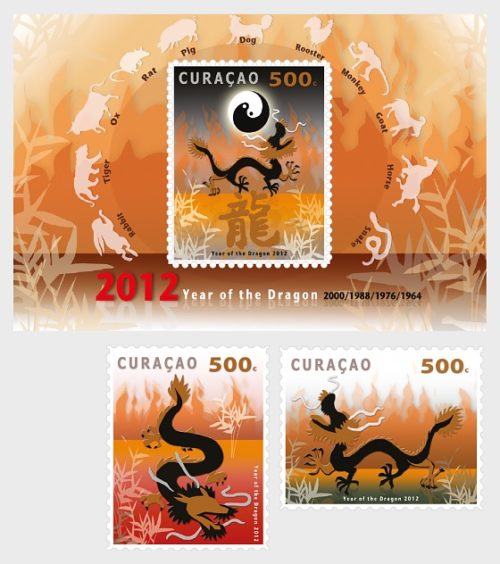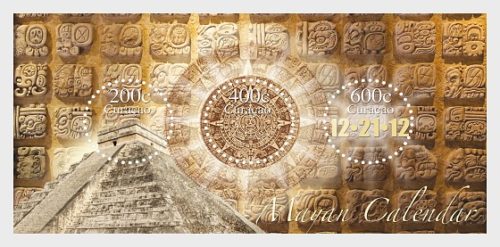Description
Cpost International is proud to emit this minisheet of 8 stamps, depicting some species of Birds of the Sea and Shore. Seabirds also known as marine birds are most commonly found on, over or near the ocean. They generally live, feed and breed either partially or wholly at sea. They often have long wings and are flyers or divers. In general, seabirds live longer, breed later and have fewer young than other birds do. Most species nest in colonies, and they are famous for undertaking long annual migrations, crossing the equator.
Shore birds or ‘waders’ are those birds commonly found on coastal shores, including beaches, rocky shores, wetlands and lagoons. Shorebirds often feed and migrate along shorelines, but also live in inland areas such as wetlands, lakes and tundra. They are generally characterized by long legs, long bills and streamlined bodies.
75c Stamp- Laughin Gull
Laughing Gull (Larus atricilla). Population of this sea bird has increased over the last century, following protection. The male and female Laughing Gull usually build their nest together. If a male cannot find a mate, he may start building a nest platform and then use it to attract a female. The Laughing Gull is normally diurnal, being active during the day. During the breeding season it forages at night as well. It usually looks for food along the beach at night, but will also hover to catch insects around lights. Nests in marshes, on beaches, and on islands along coast. Slightly pointed at one end. Brown with black splotches.
150c – Stamp Dunlin (Calidris alpine)
The Dunlin is a familiar shorebird around the world. It has a bright reddish back and a black belly, and its long, drooping bill distinguish it from nearly all other shorebirds. This small shorebird is distinctive in breeding plumage, with a black belly-patch extending behind its black legs. Its head and breast are light-colored, and its back is bright rufous. In non-breeding plumage it is drab gray with a brownish head and breast. In flight it has white underwings, a white line down the middle of the upperwing, and white on either side of its rump and tail. The white underwings are especially distinctive in flight.
200c Stamp – Gannets
Gannets are the seabirds which belong to Sulidae family. Gannets are large with white and black color. The Gannets have long bills and long pointed angular wings. Gannets fly high above the sea and hunt for its food i.e. fish. Gannets catch their prey by a vertical dive from a height in the sea. It can dive high from the height of 30 m, with the speed of 100 km/h. Its physical structure helps them to do this. Gannets have air sacs under their skin of face and chest, which acts like cushion under water. Also their eye positions give them a binocular vision, which allows them to judge distances accurately. Gannets are colonial breeders. It breeds a chalky blue egg on islands and coasts. A Gannet becomes mature in five years.
225c Stamp – Frigatebird
Frigatebirds are the seabirds which belong to a Fregatidae family under genus Fregata. Fregata itself holds five species. Frigate birds are also known with the names Pirate birds, Man of War birds and frigate pelican. The bird has long bills, wings and tails. Its feathers are black colored. However, the females have white underparts. It has long tails and long wings reaching up to 2.3 metres. Frigate bird is not able to swim, nor can they walk well. They can’t even take off from a flat ground. They have the largest wingspan than the other birds, which makes them stay in air for more than a week.
300c Stamp – Snow Egret
The word “egret” comes from the French word “aigrette” which means both “silver heron” and “brush,” referring to the long filamentous feathers that seem to cascade down an egret’s back during the breeding season. The snow egret is a shore bird from about two feet in length and has a wingspan of about three feet. It has white feathers, a yellow patch of skin around the eyes, a black bill and black legs with bright yellow feet. In breeding season, it has lacy plumes on its head, neck and back. Both the male and female build the nest. The male collects the materials and the female does the constructing. The nest is made of reeds and twigs and is placed in a bush or on the ground. The female lays three to five eggs and both parents share incubation duties. The eggs hatch in about three weeks. The eggs have an elliptical form and are greenish blue eggs of color.
350c Stamp – Flamingo
Flamingos are tall, graceful and beautifully colored birds that live and feed in shallow waters. The name Flamingo is derived from the flaming red color of the bird’s feathers, which is like the amazing color of the sunset sky. Flamingos are social birds that live in flocks, sometimes numbering thousands of birds. Like other wading birds, a flamingo has webbed feet, which help it wade through swamps and marshes in search of food. Its tall thin legs enables it to keep its body dry in shallow waters, while its long swan-like neck bends all the way downward, with its head and bill easily reaching the muddy bottom of the shallows. Flamingos’ legs bend backwards. A flamingo’s bill is roomy and is several inches long. Its upper part, or mandible, is hooked sharply, almost as if broken. Flamingos get their famous pink or orange color from the food they eat, which contains carotene.The flamingo can stand on one foot for more than four hours, and even sleep while standing on one foot. Flamingos have been widely hunted for their eggs and flesh. As a result, flamingos, once widespread, now survive in large flocks mainly in inhospitable corners of the earth. Flamingoes have a behavior that is as hard to explain as it is fun to watch: they dance. A crowd of dancing flamingoes is one of the strangest, most breathtaking sights in the natural world.
500c Stamp – Great Blue Heron
The Great Blue Heron (Ardea herodias) is a large wading bird in the heron family Ardeidae, common near the shores, lakes, rivers of open water and in wetlands. It is often seen standing at the edge of a tidal pond watching for small fish, its favorite prey. It also feeds on small mammals, reptiles, and occasionally, birds. This heron gets its name from its bluish-grey feathers and regal size. During the mating season, two feathers on the bird’s head become long and thread-like. The great blue heron’s eggs are generally light blue in color. Herons locate their food by sight and usually swallow it whole. Herons have been known to choke on prey that is too large. These species usually breed in colonies, in trees close to lakes or other wetlands. Great Blue Herons build a bulky stick nest, and the female lays three to six pale blue eggs. One brood is raised each year.
700c Stamp – Pelican
Pelicans are the large water birds which belong to family Pelecanidae. Pelicans come under the order Pelecaniformes, which is also the order of other sea birds like Gannets, Boobies, Cormorants, Frigatebirds, Darters and Tropic birds. Pelicans are found in warm regions. They live on coastal waters and inland. They inhabit on all continents except Antarctica. Pelicans are relatively large birds. The distinctive characteristic of pelicans is that they have a pouch under the beak. They have short and strong legs with all toes webbed. They have a short square shaped tail including 20 to 24 feathers. Pelicans have relatively long wings. A special fiber present deep in their breast muscles helps them to hold wings horizontal while gliding. To keep their plumage waterproof, pelicans rub backs of their heads where the preen glands are present, which secrets the oil. Pelicans mainly live on eating fish, but also eat crustaceans, amphibians and even smaller birds even. They catch fish by expanding their throat pouch. Pelicans are colonial birds. In ground nesting species, problem occurs during breeding because group of males chase for a single female




